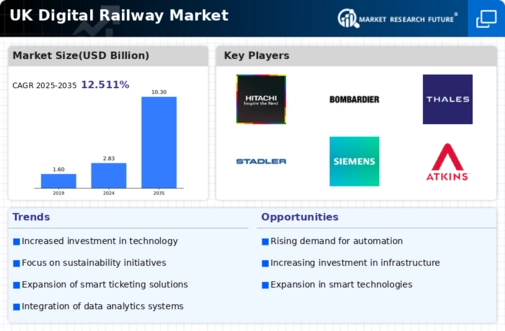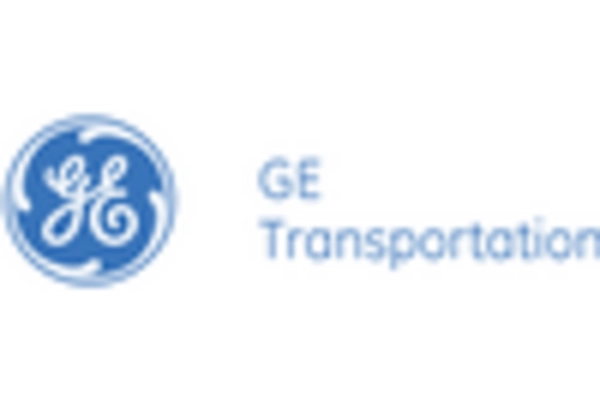Sustainability Initiatives
Sustainability initiatives are increasingly influencing the digital railway market in the UK, as operators seek to reduce their environmental impact. The UK government has set ambitious targets to achieve net-zero carbon emissions by 2050, prompting the railway sector to adopt greener technologies. Investments in electrification, energy-efficient trains, and renewable energy sources are becoming more prevalent. The digital railway market is likely to benefit from these initiatives, as they align with consumer preferences for sustainable travel options. Recent surveys indicate that over 60% of passengers are willing to pay a premium for eco-friendly travel solutions. This shift towards sustainability not only enhances the market's appeal but also contributes to the broader goal of creating a more sustainable transport system in the UK.
Focus on Safety and Security
Safety and security remain paramount in the digital railway market in the UK, driving the adoption of advanced technologies. The increasing frequency of cyber threats and the need for robust safety measures have led to significant investments in cybersecurity and surveillance systems. The UK railway sector has seen a rise in spending on safety technologies, with estimates suggesting an increase of around 15% in the last year alone. This focus on safety not only protects passengers but also enhances the reputation of the digital railway market. By integrating advanced monitoring systems and predictive analytics, operators can proactively address potential risks, thereby ensuring a safer travel environment. As safety regulations become more stringent, the digital railway market is likely to evolve further, incorporating innovative solutions to meet these challenges.
Rising Demand for Real-Time Data
The digital railway market in the UK is increasingly driven by the rising demand for real-time data among passengers and operators. With the advent of mobile applications and digital platforms, passengers expect timely updates on train schedules, delays, and service changes. This demand has prompted railway operators to invest in digital solutions that provide real-time information, thereby enhancing the overall passenger experience. According to recent studies, approximately 70% of passengers prioritize real-time updates when choosing their travel options. Consequently, the digital railway market is adapting to these expectations by implementing advanced data analytics and communication systems. This shift not only improves customer satisfaction but also optimizes operational efficiency, as operators can make informed decisions based on real-time data.
Integration of Artificial Intelligence
The integration of artificial intelligence (AI) is transforming the digital railway market in the UK, offering new opportunities for efficiency and innovation. AI technologies are being utilized for predictive maintenance, optimizing train schedules, and enhancing customer service through chatbots and virtual assistants. The potential for AI to reduce operational costs by up to 20% is particularly appealing to railway operators. As the digital railway market embraces these technologies, it is likely to see improvements in service reliability and operational efficiency. Moreover, AI-driven analytics can provide insights into passenger behavior, enabling operators to tailor services to meet evolving customer needs. This integration not only enhances the operational framework but also positions the digital railway market as a leader in technological advancement.
Government Investment in Infrastructure
The digital railway market in the UK is experiencing a surge in government investment aimed at modernizing rail infrastructure. The UK government has allocated approximately £48 billion for rail enhancements over the next five years, which is expected to significantly boost the digital railway market. This funding is directed towards the implementation of advanced signaling systems, real-time data analytics, and improved communication technologies. Such investments not only enhance operational efficiency but also improve safety and reliability. The digital railway market is likely to benefit from these initiatives, as they facilitate the integration of smart technologies and promote a more connected rail network. Furthermore, the emphasis on infrastructure development aligns with the UK's broader goals of reducing carbon emissions and promoting sustainable transport solutions.

















Leave a Comment